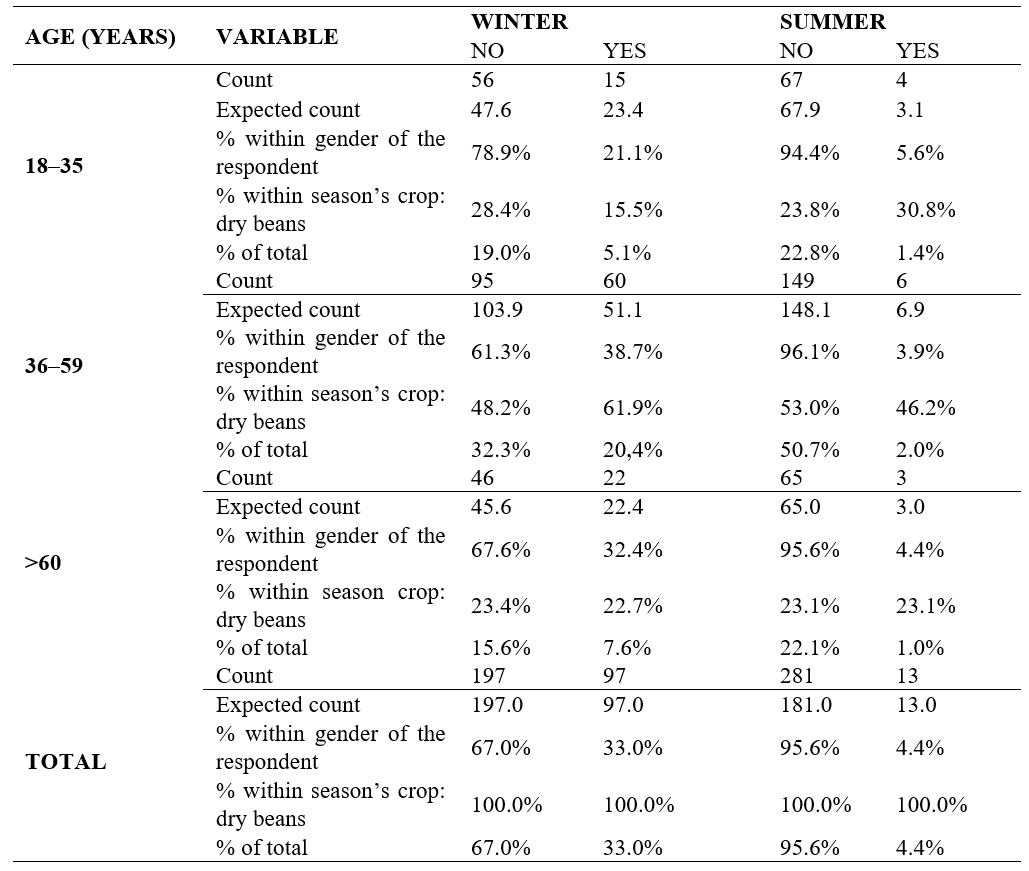Demographic Factors and Their Association with Cultivation of Dry Beans (Phaseolus Vulgaris) in Smallholder Irrigation Schemes at Vhembe District Municipality, Limpopo Province of South Africa
Abstract
The study was conducted at upper Mutale valley and Madimbo corridor irrigated smallholder agricultural enterprise. The purpose of the study was to investigate a demographic impact on the cultivation of dry beans (Phaseolus vulgaris) in irrigated smallholder agricultural enterprise. The questionnaire was developed to collect both qualitative and quantitative data. A semi-structured questionnaire was used to collect primary data at these two smallholder irrigation schemes, and administered on face-to-face interviews which embrace both open- and close-ended questions. A representative sample was based on the number of plot holders as per irrigated smallholder agricultural enterprise led by women and youth (ISHAE-WY). At least 294 women and youth plot holders were sampled for interviews and prompt responses on the investigate a demographic impact on the cultivation of dry Beans (Phaseolus vulgaris) in smallholder irrigation schemes. Chi-square test was used as descriptive analysis method through application of Fischer Exact test. The study showed weak association between gender (φ = 0.097, p = 0.096), age (φ = 0.152, p = 0.033), education (φ = 0.182, p = 0.022), and income (φ = 0.081, p = 0.163) with the planting of dry beans in ISHAE-WY. In conclusion, trends based on participation to plant dry beans shows the potential for youth to middle aged, <60 years ISHAE-WY with no primary education and obtaining less than R5 000 through dry beans production. The study also suggests empowerment programs for women and youth through literacy support and training in dry bean production practices at ISHAE-WY.
References
Cohen, J. (1988). Statistical power analysis for the behavioural sciences (2nd ed.). Lawrence Erlbaum Associates.
Department of Agriculture, Forestry and Fisheries. (2010). Dry bean production guideline. Directorate Agricultural Information Services. https://www.dalrrd.gov.za/Portals/0/Brochures%20and%20Production%20guidelines/Production%20Guidelines%20Dry%20Bean.pdf
Deribe, R. (2008). An institutional analysis of water management on communal irrigation systems in Ethiopia: The case of Atsbi Wemberta, Tigray Region and Ada’a Woreda, Oromiya Region [Unpublished master’s dissertation]. Addis Ababa University.
Diale, N. (2011). Socio-economic indicators influencing the adoption of hybrid sorghum: The Sekhukhune district perspective. South African Journal of Agricultural Extension, 39(1), 75–85.
Ekoja, I. I. (2004). Personal variables affecting adoption of agricultural innovations by Nigerian farmers. South African Journal of Agricultural Extension, 33(1), 94–107.
Grain SA. (2019). Know the value of dry beans. Pula/Imvula Magazine. https://www.grainsa.co.za/know-the-value-of-dry-beans
International Food Policy Research Institute. (2009). Climate change impact on agriculture and costs of adaptation. https://www.ifpri.org/publication/climate-change-impact-agriculture-and-costs-adaptation
Ledwaba, M. S. (2013). Evaluation of the revitalization of smallholder irrigation schemes: A case study of Krokodilheuwel irrigation project in Sekhukhune district, Limpopo Province [Unpublished master’s dissertation]. University of Limpopo.
Leedy, P. D., & Ormrod, J. E. (2005). Practical research: Planning and design (8th ed.). Prentice Hall.
Moyo, M., van Rooyen, A., Moyo, M., Chivenge, P., & Bjornlund, H. (2017). Irrigation development in Zimbabwe: Understanding productivity barriers and opportunities at Mkoba and Silalatshani irrigation schemes. International Journal of Water Resources Development, 33(5), 740–754. https://doi.org/10.1080/07900627.2016.1175339
Mphinyane, M. S., & Terblanche, S. E. (2005). Personal and socio-economic variables affecting the adoption of maize production intervention program by dryland farmers in the Vuwani District, Limpopo Province. South African Journal of Agricultural Extension, 35(2), 221–241.
Mutambara, S., & Munodawafa, A. (2014). Production challenges and sustainability of smallholder irrigation schemes in Zimbabwe. Journal of Biology, Agriculture and Healthcare, 4(15), 87–96.
Nakaz, F., Njuki, J., Ugen, M. A., Aseete, P., Katungi, E., Birachi, E., Kabanyoro, R., Mugagga, I. J., & Nanyonjo, G. (2017). Is bean really a women’s crop? Men and women’s participation in bean production in Uganda. Agriculture & Food Security, 6(1), 22. https://doi.org/10.1186/s40066-017-0102-z
Ncube, B. L. (2014). Livelihoods and production in smallholder irrigation schemes: The case of New Forest Irrigation Scheme in Mpumalanga Province [Unpublished master’s thesis]. University of the Western Cape.
Nesamvuni, A. E., Tshikolomo, K. A., Belete, A., & Motaung, M. Z. (2014). Characterization of farming households and assessment of economic viability of water users association at Mafefe Irrigation Schemes in Limpopo Province of South Africa. Journal of Agriculture and Environmental Sciences, 3(4), 71–92. https://doi.org/10.15640/jaes.v3n4a6
Pittock, J., Bjornlund, H., Stirzaker, R., & van Rooyen, A. (2017). Communal irrigation systems in South-Eastern Africa: Findings on productivity and profitability. International Journal of Water Resources Development, 33(5), 839–847. https://doi.org/10.1080/07900627.2017.1324768
Selina Wamucii Agriculture. (2023). South Africa beans 2023 retail prices. https://www.selinawamucii.com/insights/prices/south-africa/beans/
Statista. (2020). Dry beans production by province in South Africa. Statista Research Department. https://www.statista.com/statistics/1135488/dry-bean-production-in-south-africa-by-province/
Steiner, M. P., & Solem, O. (1988). Factors for success in small manufacturing firms. Journal of Small Business Management, 26(1), 51–56.
Tshikolomo, K. A., Nesamvuni, A. E., Stroebel, A., & Walker, S. (2012). Water supply and requirements of households in the Luvuvhu-Letaba Water Management Area of South Africa. International Journal of Business and Social Science, 3(3), 37–49.
United Nations. (2015). The Millennium Development Goals report 2015. http://www.un.org/millenniumgoals/2015_MDG_Report/pdf/MDG%202015%20rev%20(July%201).pdf
Urassa, J. K. (2015). Factors influencing maize crop production at household levels: A case of Rukwa Region in the Southern highlands of Tanzania. African Journal of Agricultural Research, 10(10), 1097–1106. https://doi.org/10.5897/AJAR2014.9266
Von Braun, J., & Mirzabaev, A. (2015). Small farms: Changing structures and roles in economic development (ZEF-Discussion Papers on Development Policy No. 204). Centre for Development Research.
Water Research Commission. (2009). Small-scale irrigation farming: Best management practices on selected irrigation schemes (Technical report). Republic of South Africa.


This work is licensed under a Creative Commons Attribution 4.0 International License.
Copyright for this article is retained by the author(s), with first publication rights granted to the journal.
This is an open-access article distributed under the terms and conditions of the Creative Commons Attribution license (http://creativecommons.org/licenses/by/4.0/).
























